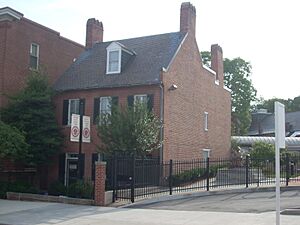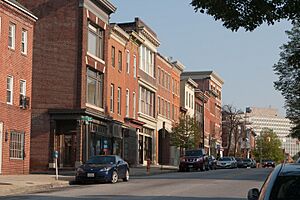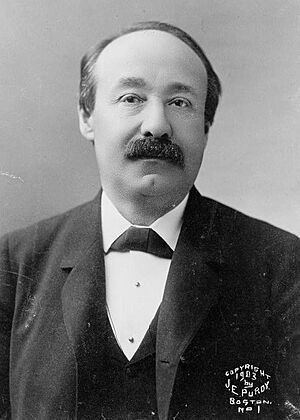History of the French in Baltimore facts for kids
The history of French people in Baltimore goes back to the 1700s. The first group of French immigrants arrived in the mid-1700s. These were Acadian refugees from Canada's Maritime Provinces. The British forced the Acadians out of Canada after winning the French and Indian War and the Seven Years' War in Europe. The British took over French lands in North America east of the Mississippi River.
Later, in the 1790s and early 1800s, more French people came to Baltimore. These were Catholic refugees escaping the French Revolution. Others were fleeing the Haitian Revolution in the French colony of Saint-Domingue.
In recent times (late 1900s and 2000s), more Creole and French speakers have moved to Baltimore. They came as refugees from Haiti, a country that has faced many political problems and natural disasters.
Contents
French Speakers in Baltimore
In 1920, about 626 people born outside the U.S. in Baltimore spoke French as their first language.
By the year 2000, about 47,234 people in the Baltimore metropolitan area said they were French American. This was about 1.9% of the area's population. Another 10,494 people (0.4%) identified as French Canadian American. So, in total, about 57,728 people in the Baltimore area had French roots.
In the same year, about 5,705 people in Baltimore city spoke French or French Creole at home.
By 2013, an estimated 5,383 French-Americans lived in Baltimore city. This was about 0.9% of the city's population. Another 1,007 people, or 0.2% of the population, said they were of French-Canadian descent.
French History in Baltimore
Acadian Refugees Arrive
The French and Indian War was a big conflict in North America from 1754 to 1763. It was part of the larger Seven Years' War happening in Europe. There was a lot of fighting between British and French people in Acadia. This area is now parts of Canada and the U.S. state of Maine.
In 1755, the British forced out the French-speaking Acadians. About 11,500 Acadians were sent away from their homes. Many of the Acadians who survived went to Louisiana, which was a French colony. Their descendants there are known as Cajuns. Other Acadians returned to France or settled in places like Baltimore.
Ships carrying 913 Acadian refugees arrived in Maryland in November 1755. People in Maryland were not very friendly to them because of the war. So, the Acadians had to rely on themselves. Many Acadian men used their fishing skills to become sailors and dock workers.
French Catholics Settle in Baltimore

During the French Revolution (1789–1799), many French Catholics left France. They were escaping religious persecution. Among those who came to Baltimore were the Sulpician Fathers. This was a Catholic teaching group. Many of the first Catholic schools and churches in Baltimore were started by these French refugees.
The Sulpician Fathers founded St. Mary's Seminary and University and St. Mary's Seminary Chapel. They also started Catholic places in other parts of Maryland, like Mount St. Mary's University. Elizabeth Ann Seton, an American woman, owned a home near St. Mary's Seminary.
She later moved to Emmitsburg and started the Sisters of Charity. This was the first group of nuns in America. In the 1960s, Seton's home was fixed up to look like it did originally. Today, it is a museum. The original seminary buildings were taken down in the 1970s. The area is now part of St. Mary's Park in the Seton Hill Historic District.
Franco-Haitian Refugees Arrive
Around the time of the French Revolution, there was a related slave revolt in the French colony of Saint-Domingue. This island is in the Caribbean. Enslaved people fought for and won their freedom, creating the new country of Haiti.
Many French-speaking Black and white Catholic refugees from Saint Domingue came to Baltimore. About 1,500 Franco-Haitians fled the island. These refugees included white Creoles, their enslaved African workers, and many free people of color. Some of the free people of color also owned enslaved people.
Along with the Sulpician Fathers, some of these refugees and their families helped start St. Francis Xavier Church. This church is the oldest historically Black Catholic church in the United States.
During the violent Haitian Revolution, Baltimore city passed a rule. It said that all enslaved people brought from the West Indies, including Haiti, were "dangerous to the peace and welfare of the city." The rule ordered slaveowners to send these enslaved people away.
French Town in Baltimore
In the 1750s, the French Acadian refugees from Nova Scotia created a community. It was located along South Charles Street near Lombard Street. This area became known as "French Town." By the 1830s, fewer Acadians seemed to be living in Baltimore. They either blended into the larger community or moved away. Because of this, French Town stopped being a distinct ethnic community.
The area that was once called Frenchtown is now known as the Seton Hill Historic District.
French Culture in Baltimore
An annual French Fair is held in Seton Hill. For example, in 2014, it was on October 11th from 12 PM to 5 PM in Saint Mary's Park. The Seton Hill Association hosts this fair to celebrate the neighborhood. It was once Baltimore's French Quarter. The fair shows off city living and has vendors selling French-themed food. It also features several music performers. Other activities have included hula hooping, petanque (a French game) in the park, a flea and craft market, and a kids' corner with building activities and entertainment.
The Baltimore French School was started in 1990. It was founded by a French immigrant who teaches the French language at Johns Hopkins University and the Peabody Conservatory.
Famous French-Americans from Baltimore
The Bonaparte Family in Baltimore
A branch of the famous Bonaparte family lived in Baltimore. Jérôme Bonaparte, who was the youngest brother of Emperor Napoleon I, traveled to Baltimore. He came to meet a friend he had made in the French Navy. While there, he met his future wife, Elizabeth Patterson, also known as Betsy. They were married by the archbishop of Baltimore on Christmas Eve in 1803.
However, Napoleon later canceled their marriage. Jérôme was forced to go back to France. Betsy Bonaparte continued to live in Baltimore with their son, who was also named Jérôme.
Their grandson, Charles Bonaparte, became a well-known lawyer and politician. He served as Secretary of the Navy and later as the Attorney General of the United States. While he was Attorney General, he helped create the Federal Bureau of Investigation (FBI).
Other Notable People
- Julie Bowen, an actress.
- John J. Chanche, the first Roman Catholic Bishop of Natchez, Mississippi.
- Cipriano Ferrandini, an immigrant from Corsica who was a barber/hairdresser at Barnum's Hotel in Baltimore for a long time.
- Maximilian Godefroy, an architect and civil engineer.
- Sidney Lanier, a musician, poet, and author.
- Michael Levadoux, a French Sulpician immigrant who helped found St. Mary's Seminary in Baltimore.
- Ambrose Maréchal, a leader in the Roman Catholic Church who served as the third Archbishop of the Archdiocese of Baltimore.
- Alphonse Magnien, the superior at St. Mary's Seminary and University from 1878 to 1902.
- Jean Baptiste Ricord, a doctor and naturalist.
- Elizabeth Ann Seton, the first person born in the United States to be made a saint by the Roman Catholic Church.
- Frank Zappa, a musician, bandleader, songwriter, composer, and film director.



